Louisiana’s Swamp Defenders
Air Date: Week of September 25, 2015
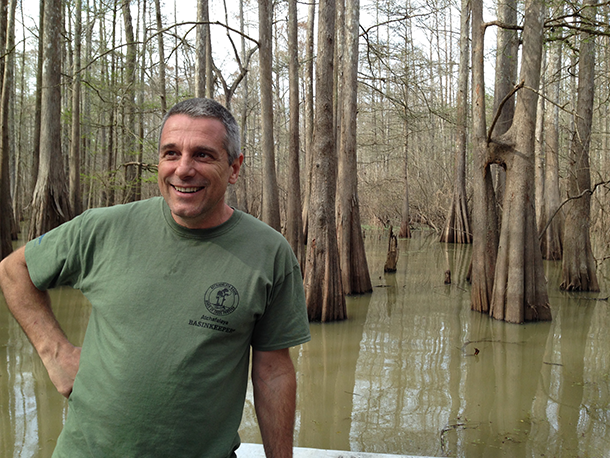
Dean Wilson. (Photo: Emmett FitzGerald)
Once, cypress swamps covered hundreds of thousands of acres across the American South. Logging, oil and gas extraction and swamp drainage transformed the landscape. But over recent years, Dean Wilson has worked to protect the remaining cypress swamps of Louisiana’s Atchafalaya Basin from illegal loggers and oil prospectors. Recently, the European biomass industry has set up shop in the state, and conservationists are concerned for the future. Living on Earth’s Emmett FitzGerald reports.
Transcript
CURWOOD: It's Living on Earth, I'm Steve Curwood. If you drive from New Orleans to Baton Rouge, you might notice that much of the road is built on stilts. That’s because there’s little solid ground in Southern Louisiana. But there is a fair amount of wetland, with trees rising up out of the water. Cypress swamp used to cover much of the American South, but today it’s only found in isolated pockets. The Atchafalaya Basin in Louisiana is one of the country’s last great Cypress swamps, and that’s where Living On Earth’s Emmett FitzGerald met up with a man determined to help save it.
FITZGERALD: Dean Wilson doesn’t sound like a Cajun, but he’s been living in the swamps of Southern Louisiana for 30 years now.
WILSON: I remember the first time I saw the swamp I fell in love with it. You know you see the beautiful green trees, with the Spanish moss, over water, and those egrets flying around like angels. Uh, I just really fell in love with that.
FITZGERALD: Dean grew up outside of Madrid, in Spain, but he came to Louisiana in his early twenties on his way to South America. He wanted to get used to the humidity and the mosquitoes before doing scientific research in the Amazon. But he never left the Bayou State.
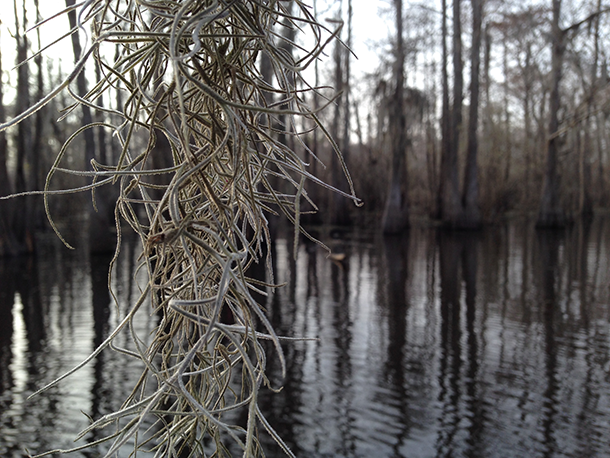
Spanish moss (Photo: Emmett FitzGerald)
WILSON: When I realized I could actually make a living off the land, I decided to stay. I was a commercial fisherman for 16 years, full-time. So I made my living hunting and fishing the swamps in the Atchafalaya Basin for 16 years.
FITZGERALD: Dean says people call all kinds of marshy wetlands swamps, but true swamps are actually pretty rare, and the Atchafalaya Basin is the largest in the United States.
WILSON: And the difference between a swamp and a marsh is that a swamp is a flooded forest. So you actually go in the springtime when the waters high you go with a boat through the forest and you can see the birds and the animals the otters minks alligators all the things that live in the swamp. It’s a magnificent place. One of the most beautiful places on earth. The Cypress trees grows to different shapes; they can live to up to 4000 years old. So the Cypresses are incredibly beautiful.
FITZGERALD: A few years ago, Dean gave up commercial fishing and turned his attention to protecting the ancient Cypress forest he calls home. Now, Dean patrols the swamp in his little motorboat as the head of the conservation organization Atchafalaya Basinkeeper. Today Dean and I are joined in his boat by his German Shepherd Shanka, and a fellow conservationist.
ORR: I’m Paul Orr and I’m Lower Mississippi Riverkeeper.
FITZGERALD: Mississippi Riverkeeper is another environmental organization devoted to protecting the area’s wetland resources. Paul unties our boat and we push off into the channel.
ORR: Here we go.
[MOTOR NOISE]
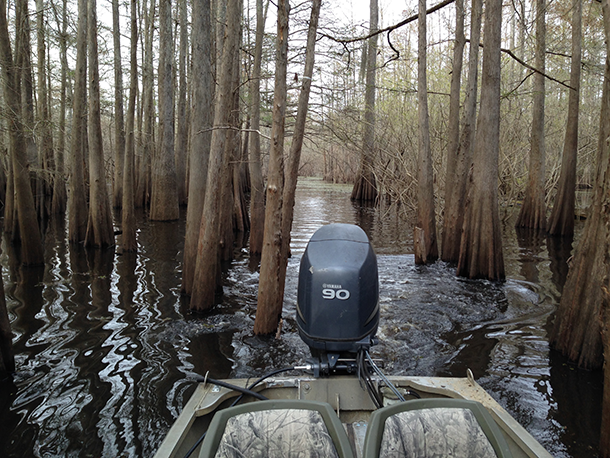
Floating through the cypress swamp (Photo: Emmett FitzGerald)
FITZGERALD: Dean steers the boat out of the main channel into the flooded forest. The depth of the water in here varies with the seasons. It’s early spring, when the water level is low, and our boat gets stuck on the mucky bottom.
ORR: The water, you know, as the snow melts up north the Mississippi River rises, but obviously we haven’t gotten to a high enough of a rise to get through here yet.
FITZGERALD: Right
ORR: Do you want me to push while you steer?
WILSON: Yeah, that would be good. Thank you Paul.
FITZGERALD: There we go. We’re free.
ORR: Always an adventure.
[BOAT NOISES]
FITZGERALD: Dean pulls the boat through the undergrowth into a clearing in the forest, and suddenly hundreds of giant cypress trees are all around us. Their trunks flare out at the bottom like grass skirts. Dean says this cypress forest is teeming with life.
WILSON: The swamps of the Atchafalaya are considered by scientists the most productive in the entire world. You can go to the Amazon and you may have more biodiversity, but if you get an acre of the Atchafalaya Basin and you’re supposed to get more pounds of fish and crawfish than any other wetlands in the world.
FITZGERALD: Full-grown cypress trees have nooks and cavities that birds love to nest in.
WILSON: Nearly half of the waterfowl population in North America come at one time or another through the Atchafalaya basin. So it is a critically important ecosystem not only for North America but the whole western hemisphere.
FITZGERALD: As we float between the trunks, Dean says swamps like this one once covered much of the American South.
WILSON: Most people have seen the Amazon river flooding millions of acres of rainforest. The Mississippi used to do the same thing, used to flood 24 million acres of forest. For somebody to picture how big is 24 million acres, there was a time when you could get in a boat, right now this time of year and through this water, could go through this forest, and never leave the forest all the way to Missouri.
FITZGERALD: But that five-hundred-mile waterway didn’t last. A lucrative timber industry developed in Louisiana around 1700. And then in the 19th century new steamship technology allowed companies to log southern cypress forests quickly and efficiently.
WILSON: By the year 1900 it was the largest industry in coastal Louisiana, was the cypress logging industry. Uh, and people thought it would last forever. By 1920, it was all over. They logged every single forest in this state. Didn’t leave a single acre standing.
FITZGERALD: In 1927, the Mississippi River spilled its banks, killing hundreds of people and displacing hundreds of thousands in the most destructive flood in US history. The Army Corps of Engineers responded to the crisis by building levees all up and down the Mississippi to control the flow of the river. The levees were designed to protect cities like New Orleans, but they straight-jacketed the river and prevented the natural flooding of Louisiana’s cypress swamps.
WILSON: It drained all those forests. Farmers came in, they cut those trees down and today it’s mainly farmland. When people drive through Arkansas, Northern Louisiana, Mississippi through what is called the Delta area, it’s all farmland but it used to be like the Atchafalaya Basin.
FITZGERALD: Today although the Atchafalaya Basin is smaller than it once was, it’s still one of last great cypress swamps left in the United States. Like all swamps it’s protected under the federal Wetlands Protection Act, and Dean Wilson and Paul Orr want to do everything in their power to preserve it. In 2008, they noticed an uptick in illegal logging in the Atchafalaya. They followed the supply chain all the way to the garden mulch aisle.
ORR: We realized pretty quickly from following the logs and then finding bags of cypress mulch and following those to Wal-Mart, Lowes and Home Depot that there was this tremendous push to try and build a cypress mulch industry.
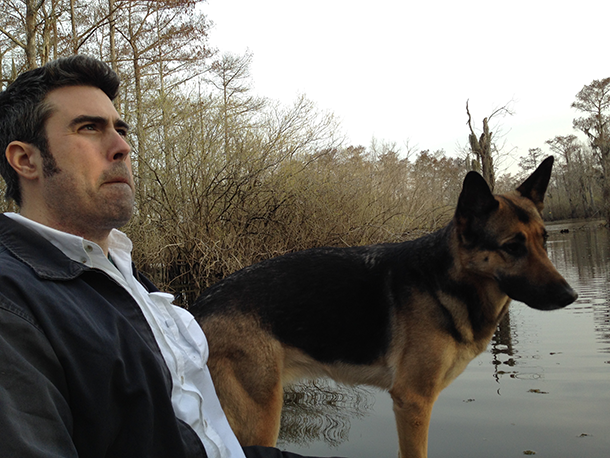
Paul Orr and his dog Shanka (Photo: Emmett FitzGerald)
FITZGERALD: But Dean says the companies that supplied the mulch weren’t clear about where it came from.
WILSON: Home Depot, Lowes and Wal-Mart were selling the mulch as environmentally harvested. The bags would say “Made with environmentally-harvested cypress, from Florida” – you have a Florida address, so they were actually deceiving the public into buying their mulch.
ORR: And deceiving the retailers — I think that some of the retailers were not very happy that that was not what they said it was.
FITZGERALD: So when Paul and Dean brought this issue to the attention of the retailers in 2008, the stores agreed to stop selling Louisiana Cypress mulch. But Dean’s still worried about illegal logging. He says the problem is enforcement.
WILSON: We have laws to protect wetlands, the problem is those laws are not being enforced, and the government isn’t even putting in the resources to enforce them, they don’t even have a boat, so they can’t be enforced.
FITZGERALD: And Paul Orr believes that problem starts with the cozy relationship between big business and the state government.
ORR: I guess it was like the late 90s, early 2000s, the Louisiana Department of Economic Development put an ad in a lot of national publications and it was like a guy in a suit doing a back bend and it said, “Louisiana bends over backwards for business”. And that’s really been the culture in Louisiana — the wealthy business people just give away all of our natural resources and our tax monies and everything for business.
FITZGERALD: Among the latest businesses to arrive in Louisiana are European power companies. In the past ten years, they have begun harvesting wood in the Southern US to burn for power back home. This type of electricity production is called biomass energy, and Adam Macon, campaign director with the environmental nonprofit the Dogwood Alliance, says that it’s taken off in Europe as the result of a decision to classify trees as renewable.
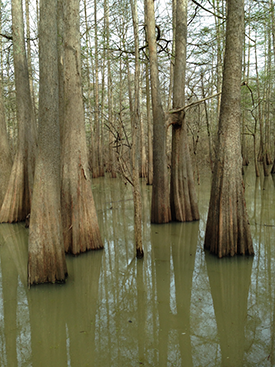
Cypress trees grow in standing water. (Photo: Emmett FitzGerald)
MACON: And it was really a mishap in an old IPCC report that essentially classified all forms of biomass as carbon neutral, meaning that when they burn them, they would be counted as zero in terms of countries counting their carbon emissions. So that really opened the floodgates for trees and forests to be chopped down and burned, because it was all being counted as carbon neutral.
FITZGERALD: Western Europe tightly regulates what forests it has left, so it’s easier for energy companies to come all the way over here to harvest trees from states like Louisiana, Mississippi, and North Carolina, where Adam Macon says a lot of the forests are on unregulated private land.
MACON: So essentially it’s the wild wild west of logging. Companies can come in and log anywhere, use any kind of logging practices generally unchecked. So it’s the perfect place for an expanding industry like the wood pellet industry to come in and be able to get a lot of wood very cheaply and very quickly.
FITZGERALD: And Adam says it’s only cheap because it’s getting EU renewable energy subsidies.
MACON: If the subsidy structures were not in place that were incentivizing renewable energy, this would not be an economically feasible industry. I mean, they are getting wood from one country, shipping it all the way across the Atlantic,, and then just burning it in a power station so it’s not that efficient. But currently, because of the subsidies, it’s a cheap form of energy.
FITZGERALD: There’s a simple logic to classifying biomass as renewable: trees grow back. If you cut down a tree and burn it for electricity, all you have to do is plant another one in its place to sequester all of the carbon that you emitted when you burned that first tree. But Adam says that doesn’t account for time.
MACON: The issue is that trees take a very long time to grow back, particularly these hardwoods in wetland forests that we’re working so hard to protect. And when you’re thinking about the carbon analysis from that perspective and in terms of mitigating the worst effects of climate change, we realize that we don’t have 50, 60, 70 years to wait.
FITZGERALD: In the meantime, some recent studies have found that burning biomass could pollute as much as or more than coal over a 50-year period.
MACON: We all know that coal is a dirty form of energy. And we need to move away from coal. But if the solution is to burn a form of energy that is emitting 3 times as much carbon into the atmosphere and count it as zero because the fact that 70 - 80 years from now, hypothetically, that forest is going to grow back, we have to acknowledge that we’re moving backwards there, not forwards.
FITZGERALD: Adam Macon says the biomass industry isn’t just a problem for the climate, it’s changing the nature of Southern forests. Where once you had different types of native hardwood forests, now it’s mostly planted pine.
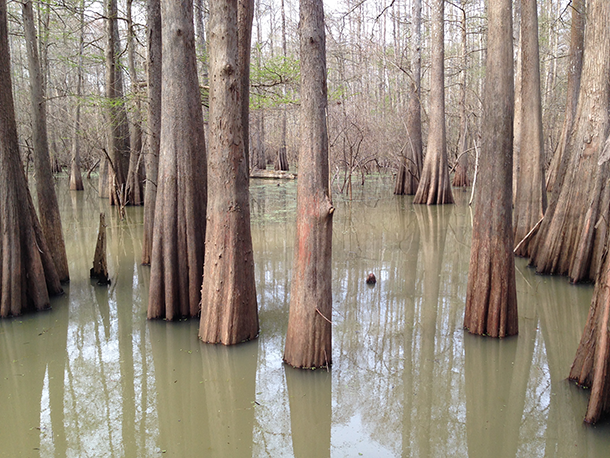
Cypress swamps once covered much of the U.S. South. (Photo: Emmett FitzGerald)
MACON: Forests have just become a complete crop in these areas. They have converted so many many acres of precious wetland areas to monoculture pine plantations. And a pine plantation contains about 95 percent less biodiversity than a native standing forest.
FITZGERALD: But Professor Dale Greene of the University of Georgia says biomass producers aren’t clear-cutting virgin woodlands; they’re mostly operating in forests that have been intensively managed for years.
GREENE: What’s really at the nub of the debate is whether you assume you found the forest, or whether you assume the forest you’re about to harvest is one you planted yourself and invested in and took care of for 20 or 25 years.
FITZGERALD: For the most part Professor Greene says biomass companies are harvesting pulpwood that might have otherwise been used for paper production. Because most of the land in the South is privately owned, he says you need industries like biomass to encourage landowners to keep their property covered in trees.
GREENE: What we’ve clearly seen historically is the stronger the markets for wood the more likely landowners are to replant. And that’s our real threat to our forest acreage, is landowners deciding to harvest their trees and put it into row crops or put it into pasture and put cows on it.
FITZGERALD: And while a pine plantation may not have as much biodiversity as a native cypress forest, it’s better than a pasture.
GREENE: A stand of trees, even if it's a stand of planted pine trees, does much better for our air and water and wildlife habitat than a field of soybeans or a bunch of cows out there on the landscape.
FITZGERALD: Dale Greene says until we can find a better way to store energy from intermittent sources like wind and solar, biomass is one of the only renewable energy sources that’s ready when you need it. But Dean Wilson bristles when he hears the word renewable used to describe forests like the Atchafalaya where we are today.
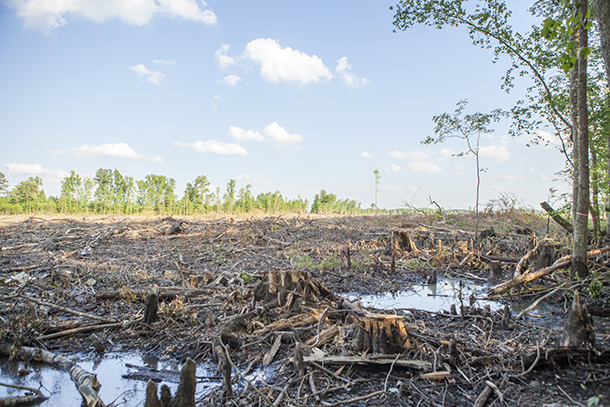
A clear cut with felled cypress trees in North Carolina. The Dogwood Alliance says this is linked to pellet production. (Photo: Dogwood Alliance)
WILSON: Because what people think when they hear that is that these wild forests in Louisiana are renewable and if you cut them down, they come back. They have the potential in theory to come back but in reality they don’t. And as you can see here they didn’t.
FITZGERALD: He points to a stand of ash trees where a century and half ago cypress stood tall. When loggers cut down the cypress a hundred years ago, different species replaced them because the conditions weren’t right for cypress anymore. Dean says that the hydrology of the region has changed so much since the Army Corps of Engineers started building levees that there’s almost no chance for cypress regeneration today.
WILSON: So anything you cut today, it ain’t going to come back, in this area.
FITZGERALD: It’s unclear whether biomass producers in Louisiana will ever log the Atchafalaya Basin. A British power company called Drax recently built several wood processing facilities in Louisiana, but so far it’s been using pine from plantations. In April, 2015, Dean Wilson met with Drax, and company officials assured him that they would not harvest cypress from wetlands like the Atchafalaya. Drax touts its biomass as sustainably harvested. The company says that it uses mostly waste wood and leftovers from timber harvests, and it doesn’t source from virgin wetland forests, but Adam Macon of the Dogwood Alliance says he’s been to biomass clear-cuts in North Carolina.
MACON: We know from North Carolina and Virginia that this industry and pellet manufacturers such as Drax and Enviva are not above logging in wetland forests, they’re actively doing it and they’re going to be actively doing it in Louisiana if they can get their hands on it.
FITZGERALD: The Dogwood Alliance is working to organize communities across the South to fight the biomass industry and convince Europe to stop subsidizing wood pellet production. Dean Wilson is focused a little closer to home, trying to protect the wetland forest where he lives. But he says it’s hard to convince local people to care about a swamp.
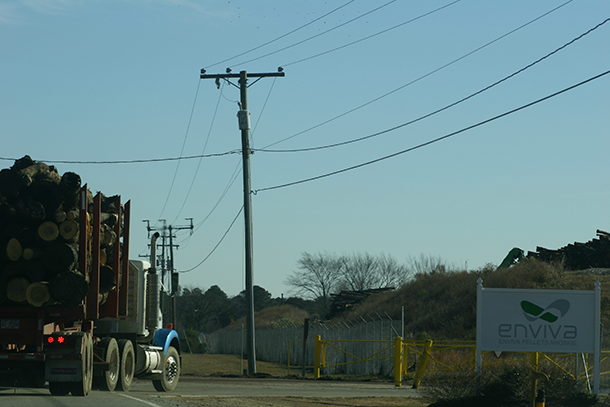
Whole trees entering the Enviva wood pellet manufacturing facilities in Ahoskie, North Carolina. (Photo: Dogwood Alliance)
WILSON: The problem is most Louisianans never been in a swamp. Hollywood give you the image of a swamp being a nasty place. Dead, full of mosquitoes so who cares if they cut it down? That’s what people feel about swamps. I don’t know how to change that.
FITZGERALD: Paul Orr says that whether people know it or not, wetlands like the Atchafalaya are vital to the state. They shelter cities from storms, provide fish habitat for the lucrative seafood industry, and they’re uniquely of this place.
ORR: The swamp epitomizes the culture of Louisiana, sort of the heart and soul of Louisiana, it’s where the Cajun culture evolved and I think you can quantify it by saying like oh it’s important for migratory birds, it’s important for animals, it’s important because it reduces storm surge, but it’s also -- there’s a sort of intangible connection that Louisiana has to the swamp.
FITZGERALD: But Louisiana has also long played host to many of the nation’s extractive industries. Paul Orr says oil, timber, and chemical companies have been pillaging the state’s natural resources for years, and there’s a limit to how much Louisiana can give.
ORR: When all the oil is gone, when all the trees are cut down, what is Louisiana going to have? These are the things that I think are the most important to preserve for future generations because it’s really what makes Louisiana unique.
FITZGERALD: Floating through this flooded forest with Paul Orr and Dean Wilson, two dedicated swamp defenders, I can understand why they don’t want to give this up.
For Living on Earth, I’m Emmett FitzGerald in Louisiana’s Atchafalaya Basin.
Links
Dean Wilson’s organization Atchafalaya Basinkeeper
Drax pulls out of £1bn carbon capture project
Investigation: Does the UK's biomass burning help solve climate change?
UK to build world’s first power plant with negative emissions
Living on Earth wants to hear from you!
Living on Earth
62 Calef Highway, Suite 212
Lee, NH 03861
Telephone: 617-287-4121
E-mail: comments@loe.org
Newsletter [Click here]
Donate to Living on Earth!
Living on Earth is an independent media program and relies entirely on contributions from listeners and institutions supporting public service. Please donate now to preserve an independent environmental voice.
NewsletterLiving on Earth offers a weekly delivery of the show's rundown to your mailbox. Sign up for our newsletter today!
 Sailors For The Sea: Be the change you want to sea.
Sailors For The Sea: Be the change you want to sea.
 The Grantham Foundation for the Protection of the Environment: Committed to protecting and improving the health of the global environment.
The Grantham Foundation for the Protection of the Environment: Committed to protecting and improving the health of the global environment.
 Contribute to Living on Earth and receive, as our gift to you, an archival print of one of Mark Seth Lender's extraordinary wildlife photographs. Follow the link to see Mark's current collection of photographs.
Contribute to Living on Earth and receive, as our gift to you, an archival print of one of Mark Seth Lender's extraordinary wildlife photographs. Follow the link to see Mark's current collection of photographs.
 Buy a signed copy of Mark Seth Lender's book Smeagull the Seagull & support Living on Earth
Buy a signed copy of Mark Seth Lender's book Smeagull the Seagull & support Living on Earth

